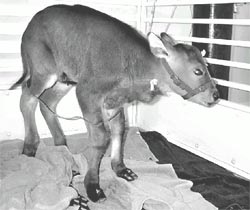Gaur clone dies
 gaur, an endangered ox-like animal, native to Southeast Asia and India, was successfully cloned, making it the first endangered species to be cloned. But the cloned animal, named Noah, succumbed to clostridial enteritis, a bacterial infection that is almost universally fatal to infected newborn animals. Gaur is brown or black in colour with a hump-like ridge on the back, weighing a tonne or more. It has been hunted to the point of endangerment.
gaur, an endangered ox-like animal, native to Southeast Asia and India, was successfully cloned, making it the first endangered species to be cloned. But the cloned animal, named Noah, succumbed to clostridial enteritis, a bacterial infection that is almost universally fatal to infected newborn animals. Gaur is brown or black in colour with a hump-like ridge on the back, weighing a tonne or more. It has been hunted to the point of endangerment.
Philip Damiani, researcher at the privately held company Advanced Cell Technologies, based in Worcester, Massachusetts in the us, is quoted in a January 13, 2001 news report in The New York Times as saying, "Even though we did lose Noah, this is still a major breakthrough.' He said the experiment showed that cloning could be used to perpetuate rare species and to even keep some endangered animals from going extinct. Noah was cloned using the cells of a male gaur who had died eight years ago at the San Diego zoo in the us . Its skin cells had been frozen at the time hoping to clone it one day. The research team took the nucleus out of hundreds of skin cells and put them into the hollowed-out eggs of domestic cows. They got 40 embryos and implanted them into cows. Only one successful pregnancy resulted. Noah was born weighing 36 kg.
Damiani said they would try again. "We have the cells that are still frozen. We can make fresh embryos. All we have to do is thaw out the cells and make the embryos again,' he said.
The company hopes to clone an endangered mountain goat later this year. It is still negotiating with the Spanish government over this. Damiani said his group is looking at using cross-species cloning on animals that are less closely related.
